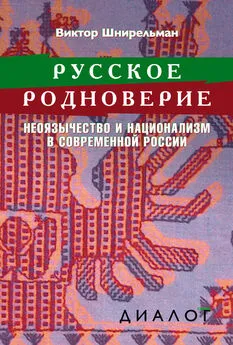Виктор Шнирельман - «Порог толерантности». Идеология и практика нового расизма
- Название:«Порог толерантности». Идеология и практика нового расизма
- Автор:
- Жанр:
- Издательство:Литагент НЛО
- Год:2014
- Город:Москва
- ISBN:978-5-4448-0342-4
- Рейтинг:
- Избранное:Добавить в избранное
-
Отзывы:
-
Ваша оценка:
Виктор Шнирельман - «Порог толерантности». Идеология и практика нового расизма краткое содержание
«Порог толерантности». Идеология и практика нового расизма - читать онлайн бесплатно ознакомительный отрывок
Интервал:
Закладка:
298
Kühl S. The Nazi connection: eugenics, American racism and German National Socialism. New York: Oxford Univ. Press, 1994. P. 5–7, 106; Sedgwick J. Inside the Pioneer Fund // Jacoby R., Glauberman N. (eds.). Bell Curve debate: history, documents, opinions. New York: Random House, 1995. P. 144–161; Baker L. D. From savage to Negro. P. 212–218; Swain C. M. The new White nationalism in America. P. 241–242; Tucker W. H. The funding of scientific racism: Wickliffe Draper and the Pioneer Fund. Urbana: University of Illinois Press, 2002; Beirich H. Of race and rockets // Intelligence report. Summer 2008. № 130. P. 19–21.
299
Sedgwick J. Inside the Pioneer Fund; Miller A . Professors of hate // Jacoby R., Glauberman N. (eds.). Bell Curve debate: history, documents, opinions. New York: Random House, 1995. P. 162–178; Rosen J., Lane Ch. The sources of The Bell Curve // Fraser S. (ed.). The Bell Curve wars. Race, intelligence, and the future of America. New York: Basic Books, 1995. P. 58–61. О Дженсене и его учителе Айзенке, о Шокли, Левине, Гернштейне и Мэррее, а также Раштоне см.: Alland A. Race in mind.
300
Lane Ch. Tainted sources // Jacoby R., Glauberman N. (eds.). Bell Curve debate: history, documents, opinions. New York: Random House, 1995. P. 127–128; Sautman B. Theories of East Asian superiority // Jacoby R., Glauberman N. (eds.). Bell Curve debate: history, documents, opinions. New York: Random House, 1995. P. 209–210; Mehler B. Race and «reason». Academic ideas a pillar of racist thought // Intelligence report. Winter 1999. Issue 93. P. 31.
301
Herrnstein R. J., Murray Ch. The bell curve. New York: Free Press, 1994.
302
Fraser S. (ed.). The Bell Curve wars. Race, intelligence, and the future of America. New York: Basic Books, 1995; Jacoby R., Glauberman N. (eds.). Bell Curve debate: history, documents, opinions. New York: Random House, 1995; Kincheloe J. L., Steinberg Sh. R., Gresson III A. D. (eds.). Measured lies: the Bell Curve examined. New York: St. Martin’s Press, 1996; Alland A. et al. The eternal triangle: race, class, and IQ // Current Anthropology. 1996. Vol. 37. Supplement. P. 143–181; Montagu A. (ed.). Race and IQ. New York: Oxford Univ. Press, 1999; Alland A. Race in mind. P. 139–157; Майлз Р., Браун М. Расизм. С. 64–66; Rattansi A. Racism. P. 78–85.
303
Ryan A. Apocalypse now? // Jacoby R., Glauberman N. (eds.). Bell Curve debate: history, documents, opinions. New York: Random House, 1995. P. 28.
304
Willis E. The median is the measure // Jacoby R., Glauberman N. (eds.). Bell Curve debate: history, documents, opinions. New York: Random House, 1995. P. 51–52; Wolfe A. Has there been a cognitive revolution in America? The flawed sociology of The Bell Curve // Fraser S. (ed.). The Bell Curve wars. Race, intelligence, and the future of America. New York: Basic Books, 1995. P. 122; Wieseltier L. The lowerers // Fraser S. (ed.). The Bell Curve wars. Race, intelligence, and the future of America. New York: Basic Books, 1995. P. 161–162; Hacker A. Malign neglect: The crackdown on African-Americans // The Nation. 1995. Vol. 261. № 2. P. 49.
305
Kamin L. J. Lies, damned lies, and statistics. P. 105. См. также: Lind M. Brave New Right // Fraser S. (ed.). The Bell Curve wars. Race, intelligence, and the future of America. New York: Basic Books, 1995. P. 172–178; Kincheloe J. L., Steinberg Sh. R., Gresson III A. D. (eds.). Measured lies: the Bell Curve examined. New York: St. Martin’s Press, 1996.
306
Он лишь забывал сказать о том, что Гитлер не просто видел в евреях «абсолютное зло», а создал целую сеть научных учреждений, которые усердно это «доказывали», привлекая массу «фактов и цифр».
307
Levin M. Responses to race differences in crime // Journal of Social Philosophy. 1992. Vol. 23. P. 5–29. При этом у Левина имелись единомышленники среди американских ученых. О них см.: Rigby P. African images: racism and the end of anthropology. Oxford: Berg, 1996. P. 11–25.
308
Levin M. Reply to Adler, Cox and Corlett // Journal of Social Philosophy. 1994. Vol. 25. P. 13. После этого выступления Майкл Левин потерял работу в Городском университете Нью-Йорка.
309
Ibid. P. 7. Подобно всем любителям расовой теории, Левин не задумывался о том, что если бы дело было в биологии, то криминальное поведение было бы присуще всем представителям черной расы. Между тем это было не так, ибо сам он говорил прежде всего о неженатых чернокожих юношах. Он не обсуждал вопрос о том, почему по мере взросления и со вступлением в брак многие из них порывали со своим преступным прошлым. Куда же девались их якобы биологически обусловленные преступные наклонности?
310
D’Souza D. The end of racism. P. 250–287. В 2005 г., подобно Левину, австралийский правовед Эндрю Фрэзер обвинил беженцев из Судана в прирожденном преступном поведении в связи с тем, что африканцам якобы в силу генетических причин не хватает интеллекта, но зато у них переизбыток тестостерона. При этом он ссылался, в частности, на «интеллектуальные тесты». См.: Cohen D. Australian professor sparks racial flap // Chronicle of Higher Education. 2005. Vol. 51. Issue 49. P. A42–A42.
311
Thomas L. Statistical badness // Journal of Social Philosophy. 1992. Vol. 23. P. 30–41; Adler J. E. Crime rates by race and causal relevance: a reply to Levin // Journal of Social Philosophy. 1993. Vol. 24. P. 176–184; Corlett J. A. Racism and affirmative action // Journal of Social Philosophy. 1993. Vol. 24. P. 163–175; Alland A. Race in mind. P. 130–137.
312
Kurtz H. Some journalists link crime coverage, racism // The Washington Post. 1994. July 29. P. A–11.
313
Dubow S. Scientific racism in modern South Africa. Cambridge: Cambridge Univ. Press, 1995; MacCann D., Maddy Y. A. Apartheid and racism in South African children’s literature, 1985–1995. New York; London: Routledge, 2001. P. 3–13.
314
MacCann D., Maddy Y. A. Apartheid and racism in South African children’s literature… P. 20.
315
Ibid. P. 118–120.
316
Proctor R. Racial hygiene: medicine under the Nazis. Cambridge: Harvard Univ. Press, 1988. P. 307–308.
317
Об этом см.: Kühl S. The Nazi connection. P. 3–11; Swain C. M. The new White nationalism in America. P. 245–246.
318
MacMaster N. Racism in Europe, 1870–2000. Basingstoke, Hampshire: Palgrave, 2001. P. 219–223; St Louis B. Racialization in the «Zone of ambiguity» // Murji K., Solomos J. (eds.). Racialization: studies in theory and practice. Oxford: Oxford University Press, 2005. P. 38–45; Rattansi A. Racism. P. 164. См. также: Duster T. Backdoor to eugenics. New York: Routledge, 2003.
319
Об этом см.: Carter R. Genes, genomes and genealogies: the return of scientific racism? // Ethnic and racial studies. 2007. Vol. 30. № 4. P. 520–522.
320
Steinberg D. L. Reading genes/writing nation: Reith, ‘race’ and the writings of geneticist Steve Jones // Brah A., Coombes A. (eds.). Hybridity and its discontents: politics, science, culture. London: Routledge, 2000; Brah A. Ambivalent documents/fugitive pieces: author, text, subject, and racialization // Murji K., Solomos J. (eds.). Racialization: studies in theory and practice. Oxford: Oxford Univ. Press, 2005. P. 75–76; Graves Jr. J. L., Rose M. R . Against racial medicine // Patterns of prejudice. 2006. Vol. 40. № 4/5. P. 481–493.
321
Robb P. South Asia and the concept of race // Robb P. (ed.). The concept of race in South Asia. Delhi: Oxford Univ. Press, 1997. P. 64; Zuck N. Philosophical aspects of the «AAA Statement on ‘race’» // Anthropological theory. 2001. Vol. 1. № 4. P. 457–459; PUG, race and ethnicity in Europe. The Univ. of Manchester, 2004 ( http://les1.man.ac.uk/sa/pug/documents/pamphlets/race.pdf). P. 7–8. Впрочем, сами медики, которые пытаются учитывать расовые различия, понимают, что это – достаточно грубый показатель, но другого они в ряде случаев не имеют. См.: Satel S. I am a racially profiling doctor // The New York Times. 2002. 5 May.
322
Сегодня даже некоторые антропологи замечают, что былой язык механики и физики, когда-то помогавший ученым формулировать свои мысли, сегодня сменяется языком биологии и генетики. См., напр.: Marcus G. E., Fisher M. M. J. Anthropology as cultural critique. Chicago: The Univ. of Chicago Press, 1999. P. XXVI.
323
Nelkin D. Molecular metaphor: the gene in popular discourse // Genetics Nature Reviews. 2001. Vol. 2. № 7. P. 555–559.
324
Macilwain C. Tribal groups attack ethics of genome diversity project // Nature. 1996. Vol. 383. № 6597. P. 208; Qureshi F. Worries over DNA and racial profiling // Institute of Race Relations News. 2005. 19 May ( http://www.irr.org.uk/2005/may/ak000007.html); Chakrabarti Sh. Taking DNA from innocent people is yet more fuel for the bonfire of the liberties // The Independence. 2006. 7 May.
325
United States: Testing times; Crime and punishment // The Economist. 2005. 14 May. Vol. 375. № 8424. P. 52.
326
Gilroy P. Between camps: nations, cultures and the allure of race. London: Routledge, 2004. P. 37.
Читать дальшеИнтервал:
Закладка:










